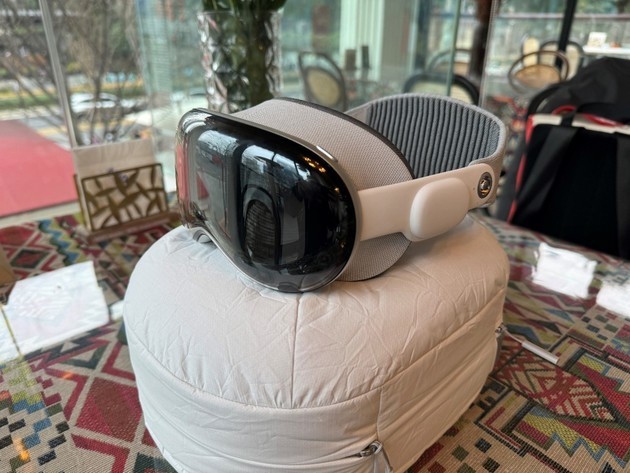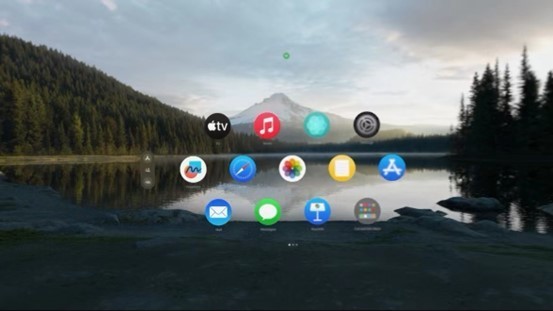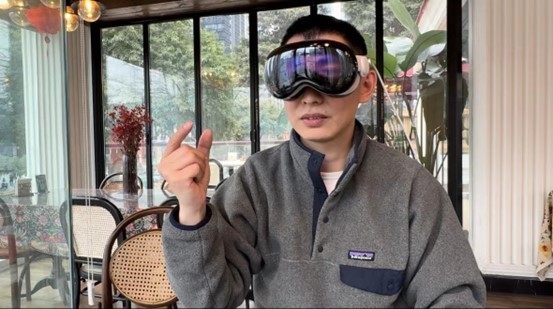On February 2nd, local time, Apple’s highly anticipated Vision Pro headset hit the US market, with CEO Cook attending the scene, and the New York Apple store packed with customers.
In Apple’s vision, Vision Pro represents the start of spatial computing. Despite the hefty price tag of $3,499, Vision Pro still sparked a frenzy on social media, with tech enthusiasts wearing the headset to drive, work out, cross the street, and take the subway, eager to share their in-depth reviews.
But in stark contrast to this craze, the market reacted rather lukewarmly - on the day of Vision Pro’s launch, Apple’s stock price fell by 0.54%.
From February 2nd to 8th, Apple’s stock price rose by only 1.33%. In terms of market acceptance, opinions on Vision Pro are mixed.
Some analysts think it might be hard to translate into a significant revenue driver, while others believe it could be a game-changer for the industry in the future. Dan Ives, managing director of WedBush Securities, said in a comment email to NBD that Apple Vision Pro Buzz Signals Cupertino Upswing. With 2.2 billion active iOS devices globally, Apple’s ecosystem will provide it with a huge market. On the day of the product launch, some tech enthusiasts in China went to the US store to pick up the product as soon as possible. Our reporter found one of the Vision Pro enthusiasts, had an in-depth conversation with him, and also tried the product.


Photo/Zheng Yuhang (NBD)
Vision Pro hands-on experience: four pros and cons
Vision Pro made a stir on social media, not only among tech lovers, but also among major media outlets such as The Verge, The Wall Street Journal, and CNBC, which all published in-depth reviews. Based on our reporter’s hands-on experience and the media reviews, we roughly summarized the four pros and cons of Vision Pro.
Pro 1: Stunning visual clarity
According to the Apple fan, “Because Vision Pro does not use real optical transparency, but rather records through multiple external cameras, processes through the built-in chip, and then forms light feedback to the human eye, the real experience delay is very low, quite stunning.” OpenAI co-founder Andrej Karpathy said on X platform that Vision Pro’s visual clarity far exceeds any previous device, and is amazing. After putting on the device, the content completely rendered by virtual reality (such as screen display) is exceptionally clear, and reading is effortless.

Photo/Vision Pro screenshot
Pro 2: Creative “spatial computing” experience
According to CNBC’s review, Vision Pro offers a new type of experience that Apple calls “spatial computing”. “You sit in your own world, looking at the digital world, and then place different applications around you.” CNBC wrote, “This reminds people of the iPhone era, when Apple introduced the multi-touch display, which changed the way we interact with phones.”

Photo/Vision Pro screenshot
For this experience, Karpathy praised, “Designing and thinking about how to arrange all the applications in my space, I feel extremely creative. My mind is fully activated, imagination unlimited.”
Pro 3: Leap in eye-hand tracking technology
For Vision Pro users, their eyes are equivalent to the pointer of the operation, and the device tracks the eyes through sensors. CNBC, The Verge, and Karpathy’s reviews all said that the accuracy of eye tracking has achieved a leap, which is very impressive. In actual operation, the fan also feedback that whether it is opening applications, viewing albums, watching movies or browsing web pages, “eye movement” and “gesture” tracking are very smooth.

Photo/Zheng Yuhang (NBD)
Pro 4: High integration with Apple’s ecosystem
Many feedbacks mentioned that Vision Pro is highly integrated with Apple’s ecosystem. This is because Apple wants to make Vision Pro a complete device, which can be on par with Mac and iPad in Apple’s ecosystem. At the same time, the freshly baked Vision Pro also has some imperfections.
Con 1: User experience is not perfect
Karpathy believes that Vision Pro deviates from Apple’s consistent brand image to some extent. In some aspects, the product may have been highly polished, while in others, it appears to be rough, unthoughtful, and even obviously problematic.
For example, he encountered bugs such as FaceID failing to recognize and unlock, and iMessage not displaying properly. The fan also feedback that after the user has a certain degree of proficiency, he hopes to operate quickly, “eye movement” and “gesture” tracking also have some small bugs, such as wanting to select but always unable to select, or an important file is accidentally deleted, which is frustrating. Just like iPhone’s face recognition and fingerprint recognition, it is easy to not recognize after a long time, and it needs to be reset. In the experience of nearly a week of Vision Pro, he has already reset the “eye movement” and “gesture” settings because of this problem.
“This gives the impression that the product seems to have been hastily pushed to the market, and the basic user interface and user experience interaction have not been perfected, lacking careful consideration and debugging.” Karpathy wrote.
Con 2: Not light enough
This is a widely criticized issue, Vision Pro itself weighs between 600 and 650 grams. In most people’s experience, weight is a noticeable drawback, even with the necessary double headband, it is hard to forget its existence. The Verge mentioned in the review, “(After wearing) for a while, the most noticeable thing about the hardware is - it’s heavy.” He said that although there is a double ring to keep it stable, it does not really reduce the overall weight of the headset after wearing it. Our reporter also feedback that wearing it for a long time feels heavy on the head, and after taking off the headset for 30 minutes, there was a red mark on the forehead.
Con 3: Digital characters are not natural enough
Although some people think that the digital avatar effect is great, many media reviews have responded that Vision Pro’s digital avatar is not natural enough, and there may even be some “uncanny valley effect”. The Verge review pointed out that there is still a long way to go in this technology. “In Musk’s words, the digital characters are impressive, but also very bad.” The review wrote.
Con 4: Expensive
Vision Pro starts at $3,499, far higher than Meta’s popular Meta Quest 2 virtual reality headset. According to reports, the display is the main reason for Vision Pro’s high price. The two displays represent a huge leap in display technology. Both are micro MicroOLED, 23 million pixels, only 7.5 microns in size, about the size of a red blood cell.
Capital market response is cold
On the day of Vision Pro’s hot sale, Apple’s stock price did not rise as expected, but fell by 0.54%. From the 2nd to the 8th, Apple’s stock price rose by only 1.33%. The market gave a rather flat feedback, forming a sharp contrast with the hot review trend on the Internet.
According to King Lip, chief strategist at BakerAvenue Wealth Management, he was not very impressed by Vision Pro, “If you look at the products released before - AirPods or iWatch, these products are obviously innovations for the masses, these devices make Apple’s profits grow and revenues soar. But for a device that sells for $3,500, even if it’s great, I’m not sure if this is an innovation for the masses, or more likely a novelty toy for the ‘privileged class’.”
Cost is a major factor for Vision Pro not being optimistic. According to foreign media, there are many companies that have headset products, as Apple’s competitors, the popular Meta Quest 2 sells for only $500, and Lenovo recently launched ThinkReality VRX starting at $1,299. Vision Pro’s high price may make it difficult to translate into a considerable revenue driver.
On the other hand, some views suggest that Vision Pro’s own limitations may imply that it cannot really sweep the market. The Verge said that Apple Vision Pro is the best consumer headset ever, and that’s exactly the problem.
Although the headset is not a new concept, Apple is the first company to aim to make the headset a spatial computer, and the company hopes to bring spatial computing to the forefront of the market through Vision Pro. The company’s vision is to make Vision Pro a complete device that can compete with Mac and iPad in Apple’s device ecosystem.
To achieve this goal, Apple had to make some trade-offs. For example, by integrating all these technologies into the headset, the product is heavy, and Apple had to use an external battery. The battery can power for two and a half hours. And once the battery is disconnected, the power supply will be completely cut off. According to our reporter’s test, the battery module, when fully charged, can only be used normally for 2 to 3 hours.
For Apple itself, the company faces the problem of sluggish growth. In fiscal year 2023, the company’s total net sales were $383.285 billion, down 3% year-on-year; net profit was $96.995 billion, down 3% year-on-year. The company recorded revenue decline for the fourth consecutive quarter, creating the longest decline record since 2001.
On February 2nd, Apple announced its first quarter financial report for fiscal year 2024, with net revenue of $119.575 billion, up 2% year-on-year; net profit of $33.916 billion, up 13% year-on-year. Despite the year-on-year growth of net revenue and net profit, the revenue of Greater China region fell by 13% year-on-year. Analysts worry that facing the fierce competition from Chinese electronic products, Apple is losing market share in China, the most critical growth region.
And earlier this year, due to a patent infringement lawsuit, the US Apple Watch lost the function of monitoring blood oxygen, and the product sales are expected to perform poorly, which is even worse for Apple.
Vision Pro, a game-changer? Under such circumstances, whether Vision Pro can be a “game-changer”, and whether it can bring Apple a hefty profit, has become a focus of discussion in the industry. Despite the flat market response, there are also voices in the industry that “Vision Pro may be hard to really sweep the market”, but at the same time, there are also many people who are optimistic that Vision Pro will become a game-changer for the industry.
Dan Ives told NBD that this is just the start for Vision Pro, with 2.2 billion active iOS devices (users) globally, Apple’s ecosystem will provide it with a huge market.
We believe this is just the start for this new form factor with our industry checks showing the next version of Vision Pro 2 will have much lower price points in the sub $2k area code (could be 2-3 models released) as Apple looks to push more aggressively towards its golden installed base. We also believe future Vision Pro models will resemble form factors that look like sunglasses over the coming years and be a much broader reach/functionality for Apple users down the road with north of 1 million Vision Pro units our initial sales bogey for FY25.
At the same time, he believes that in the future, Apple will be committed to integrating generative AI into the headset, which will mark the beginning of a new growth area for Apple’s golden user base.
“This is Apple’s first step into the AI field, and we expect Apple to discuss building a standalone AI app store at WWDC this summer. Vision Pro’s ultimate goal is to work with iPhone and other Apple devices in the next few years, and many AI use cases will explode in areas such as health, fitness, sports, etc.” He said.
Bank of America estimates that Vision Pro can add 68-89 cents to Apple’s earnings per share in the next five years. Morgan Stanley predicts that Apple’s headset business will “conservatively” increase to $4 billion in annual revenue in four years.
In addition, many venture capitalists believe that Vision Pro will bring a broad range of opportunities in the enterprise sector. Morgan Stanley said that it is “ready for adoption”, especially in areas such as virtual simulation, digital showroom, remote training, virtual marketing, etc.
Brad Harrison, founder of early-stage venture capital firm Scout Ventures, believes that Apple’s ecosystem is a guarantee for enterprises to adopt Vision Pro and integrate the device into the workplace. Apple is very familiar with enterprise applications, and this month the company has included Vision Pro in the Apple device management process, allowing IT teams to manage the device as they do with iPhone, iPad, watch, and Mac.
Harrison believes, “We have reached a turning point, where the availability, usability, integration with existing platforms, and demand will lead to real AR-based business growth.”


 川公网安备 51019002001991号
川公网安备 51019002001991号





